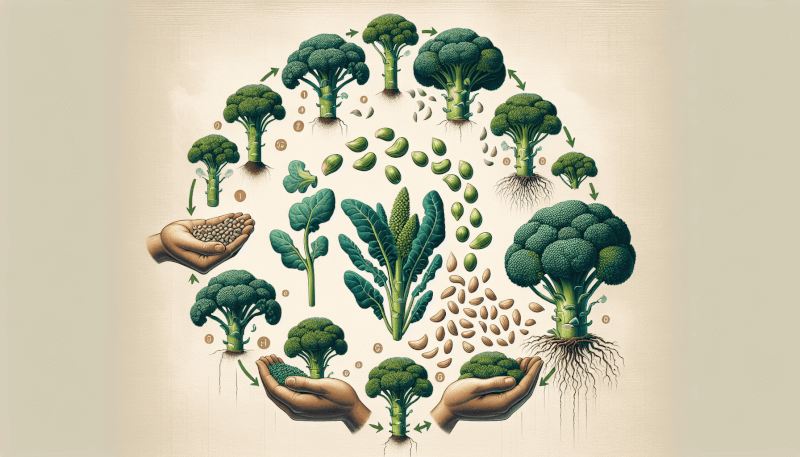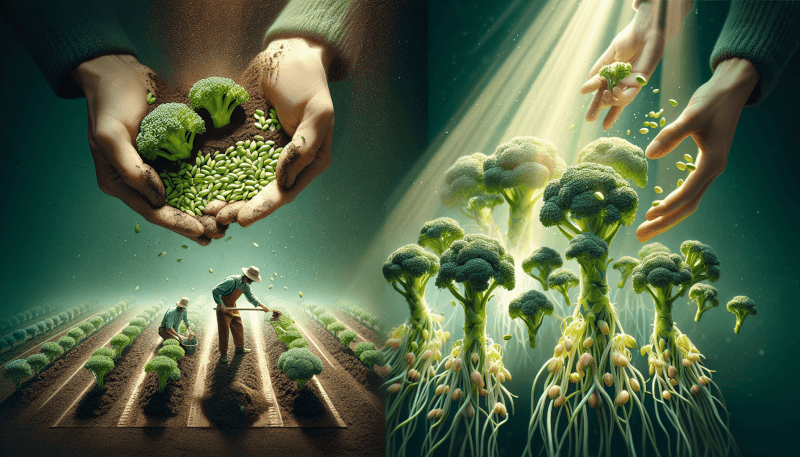👋 Click the mic button to talk to Alfred, the Todd's Seeds Gardening/Sprouting Expert – Feel free to ask him anything!
Ask Virtual Todd Anything - Click the Mic
Imagine the excitement of harvesting your own broccoli seeds and having a constant supply of nutritious, home-grown veggies right at your fingertips! In this article, we will explore the fascinating world of broccoli seeds and discover the optimal time to harvest them. Delve into the wonderful journey of growing your own food and learn how to ensure a successful harvest that will leave you feeling accomplished and satisfied. Get ready to unlock the secrets of broccoli seeds harvest time and embark on a rewarding gardening adventure that will not only fill your plate, but also your heart.
When to Harvest Broccoli Seeds
Harvesting broccoli seeds is an exciting and rewarding endeavor for any gardener. But how do you know when the seeds are ready to be collected? In this article, we will explore the signs of maturity to look for in broccoli pods and discuss the important weather considerations to keep in mind. We will also cover how to prepare for seed harvest by selecting the right varieties, determining the necessary isolation distance, and planning for succession planting. Once the seeds are fully matured, we will explore the stages of seed harvest and provide tips for properly storing your broccoli seeds for future use. So let’s dive in and learn when and how to harvest broccoli seeds!
Signs of Maturity
When it comes to harvesting broccoli seeds, the first step is to identify the signs of maturity in the pods. There are three key indicators to look for: pod color, pod texture, and pod size.
Pod Color
As broccoli pods mature, they will go through a transformation in color. Initially, the pods will be green, which is typically the color of immature pods. However, as the seeds develop inside, the pods will turn yellow or brown. This change in color indicates that the seeds are nearing maturity. Keep a close eye on the color of the pods, and once they have transitioned from green to yellow or brown, it’s a good indication that they are ready for harvest.
Pod Texture
In addition to color, the texture of the broccoli pods is another important factor to consider when determining seed maturity. When the pods are immature, they are typically smooth and tender. However, as the seeds inside mature, the pods become rougher and tougher. Run your fingers along the surface of the pods and feel for any roughness or hardness. If the pods have a rough texture and are difficult to compress, it suggests that the seeds have developed, and it’s time to harvest them.
Pod Size
Lastly, pod size can also provide insight into the maturity of broccoli seeds. As the seeds develop, the pods will gradually increase in size. Immature broccoli pods are small and compact, while mature pods become larger and more elongated. Take note of the size of the pods throughout their development, and once they have reached their full size, it’s a clear indication that the seeds are ready to be harvested.

Weather Considerations
While monitoring the signs of maturity in broccoli pods is crucial, it is also necessary to take into account the weather conditions during the seed harvest period. Broccoli plants are susceptible to both frost and hot weather challenges, which can impact the quality and viability of the seeds.
Frost Tolerance
Broccoli plants are typically cool-weather crops and can withstand mild frosts. However, when it comes to seed production, it is essential to avoid exposing the pods to freezing temperatures. Frost can damage the seeds and reduce their viability. If frost is a concern in your area, it’s important to time your seed harvest before the first frost of the season. Keep an eye on the weather forecast and plan your harvest accordingly to ensure optimal seed quality.
Hot Weather Challenges
On the other end of the spectrum, hot weather can pose challenges during broccoli seed harvest. High temperatures can cause the pods to open prematurely or dry out too quickly, resulting in poor seed quality. If you live in a region with hot summers, it’s advisable to harvest the seeds in the cooler hours of the day, such as early morning or late evening. Additionally, providing shade or light mulching around the plants can help regulate soil temperature and protect the pods from excessive heat.
Preparing for Seed Harvest
Before you can start harvesting broccoli seeds, there are a few crucial preparations to make. These include selecting seed-saving varieties, determining the necessary isolation distance, and planning for succession planting.
Seed-Saving Varieties
To ensure successful seed harvests, it is important to choose suitable seed-saving varieties of broccoli. Open-pollinated varieties are the best option for seed saving since they are more likely to produce seeds that are true-to-type. These varieties, unlike hybrids, tend to have greater genetic diversity and are less likely to cross-pollinate with other varieties, ensuring the integrity of the seeds.
Isolation Distance
To prevent cross-pollination and maintain the purity of your broccoli seeds, it’s essential to determine the appropriate isolation distance. This distance refers to the minimum space required between different varieties or species to prevent their pollen from mixing. The isolation distance depends on several factors, including the type of pollinator (insects, wind, or self-pollination) and the specific needs of your chosen broccoli variety. Consult reliable gardening resources or seed-saving guides to determine the recommended isolation distance for your particular situation.
Planting Succession
Succession planting is a technique that involves planting multiple crops of the same vegetable at staggered intervals to ensure a continuous supply of fresh produce. When it comes to seed harvesting, succession planting allows you to extend the harvest period and ensure a consistent supply of mature pods for seed collection. By planting new broccoli plants every few weeks, you can stagger their maturity dates and have a continuous cycle of seed production. This strategy is especially useful for areas with shorter growing seasons where the window for seed harvest may be limited.

Seed-Saving Varieties
When considering broccoli seed harvest, it’s important to understand the distinction between open-pollinated and hybrid varieties.
Open-Pollinated Broccoli
Open-pollinated varieties of broccoli are those that have been naturally cross-pollinated by insects, wind, or other means, without human intervention. These varieties tend to be more genetically diverse and stable, meaning that the seeds produced will closely resemble the parent plant. Open-pollinated varieties are excellent choices for seed saving since they reliably produce seeds that can be saved and replanted in subsequent seasons.
Hybrid vs. Open-Pollinated
Hybrid broccoli varieties, on the other hand, are created through controlled cross-breeding between two different parent plants. The purpose of hybridization is to combine desirable traits from different varieties, such as disease resistance or higher yields. However, seeds produced from hybrid plants may not reliably produce offspring with the same traits as the parent plant. Therefore, if you intend to save seeds, it is advisable to select open-pollinated broccoli varieties to maintain consistency and reliability in the seed stock.
Isolation Distance
To prevent unwanted cross-pollination and maintain the integrity of your broccoli seeds, it’s important to implement isolation measures.
Preventing Cross-Pollination
Broccoli plants are primarily pollinated by insects, particularly bees. To prevent cross-pollination between different broccoli varieties, they must be adequately spaced apart. The recommended isolation distance for broccoli is generally between 500 to 1,000 feet. This distance ensures that bees are less likely to transfer pollen from one variety to another, thereby maintaining the genetic purity of each variety. If space is limited, physical barriers like netting or screens can be used to prevent unwanted pollen transfer.
Planting Succession
Harvesting broccoli seeds is not a one-time event but rather an ongoing process that requires careful planning and timing. Planting succession crops of broccoli can help you optimize seed harvest and ensure a steady supply of mature pods.
Harvest Timing Planning
To plan for succession planting, consider the average number of days it takes for broccoli pods to reach maturity. This information can be found on seed packets or in gardening references. By accounting for this maturation period, you can calculate the ideal planting dates for each crop. Start by determining your desired seed harvest period and count backward to identify the best time to sow your first crop of broccoli. Then, continue planting additional crops at regular intervals to maintain a continuous harvest and maximize seed production.
Continuous Seed Production
By implementing succession planting, you can create a cycle of continuous seed production. As each crop of broccoli enters the flowering stage and begins to develop pods, earlier plantings will already be producing mature pods ready for seed harvest. This ensures a constant supply of seeds and allows you to fine-tune your harvest techniques as you gain experience throughout the successive plantings.
Harvesting Broccoli Seeds
Once the broccoli pods have reached full maturity, it’s time to harvest the seeds. Understanding the different stages of seed harvest and knowing when to collect the seeds is crucial for optimal results.
Stages of Seed Harvest
The process of seed harvest can be divided into two stages: pod development and determining seed maturity.
Pod Development
Pod development begins after the broccoli plant flowers. The flower heads will transform into small pods where the seeds will develop. Initially, the pods will be small and green. As they mature, they will gradually change color, becoming larger, and rougher in texture. Monitor the pods closely during this stage to ensure you catch them at their peak maturity.
Determining Seed Maturity
To determine if the seeds inside the pods are fully mature, select a few pods and open them. The seeds should be dry, hard, and dark in color. If the seeds are still soft or light-colored, the pods need more time to mature. Patience is key during this process, as harvesting the seeds too early may result in lower viability and compromised germination rates.
Storing Broccoli Seeds
After harvesting your broccoli seeds, it’s important to store them properly to maintain their viability and extend their shelf life. Follow these steps to ensure your seeds remain viable for future use.
Cleaning and Drying
Start by separating the seeds from the pods. Remove the mature pods from the plant and let them dry for a few weeks in a well-ventilated area. Once the pods are dry and brittle, gently separate the seeds by hand or using a clean, dry cloth. Remove any remaining debris or plant matter. Be cautious when handling the seeds to avoid damaging them, as they are delicate and can be easily crushed.
Choosing Appropriate Containers
For seed storage, it’s important to choose suitable containers that will protect the seeds from moisture, light, and pests. Opt for airtight containers such as glass jars or resealable plastic bags. Place the cleaned and dried seeds in the containers, ensuring they are tightly sealed to prevent moisture or pests from entering. Label the containers with the variety and date of harvesting for easy reference.
Seed Storage Conditions
To maintain seed viability, store the containers in a cool, dry, and dark location. The ideal storage temperature for broccoli seeds is between 32°F (0°C) and 41°F (5°C), with humidity levels below 50 percent. The refrigerator or a cool basement are suitable storage environments. Regularly check the stored seeds for any signs of moisture or mold and discard any that show signs of damage or deterioration.
By following these guidelines, you can ensure the successful harvest and storage of your broccoli seeds. Remember that seed-saving is a skill that improves with practice, so don’t be discouraged if your first attempts are not perfect. Enjoy the process and experiment with different varieties and techniques to find what works best for you. Happy seed saving!